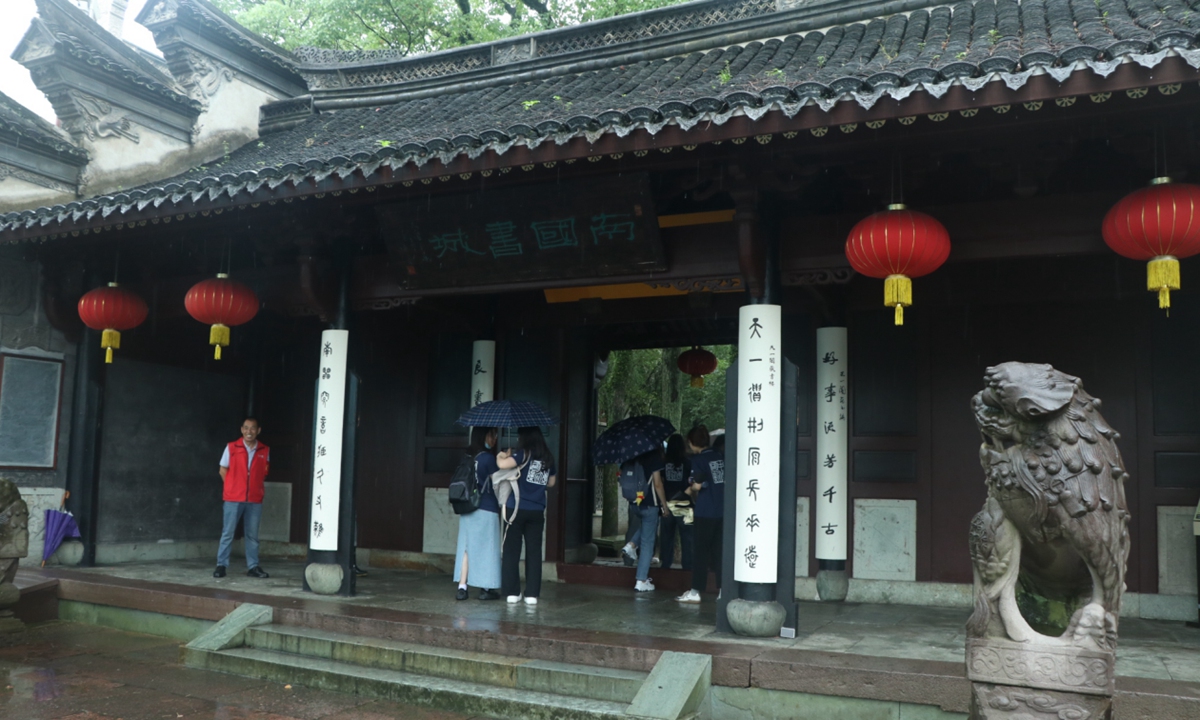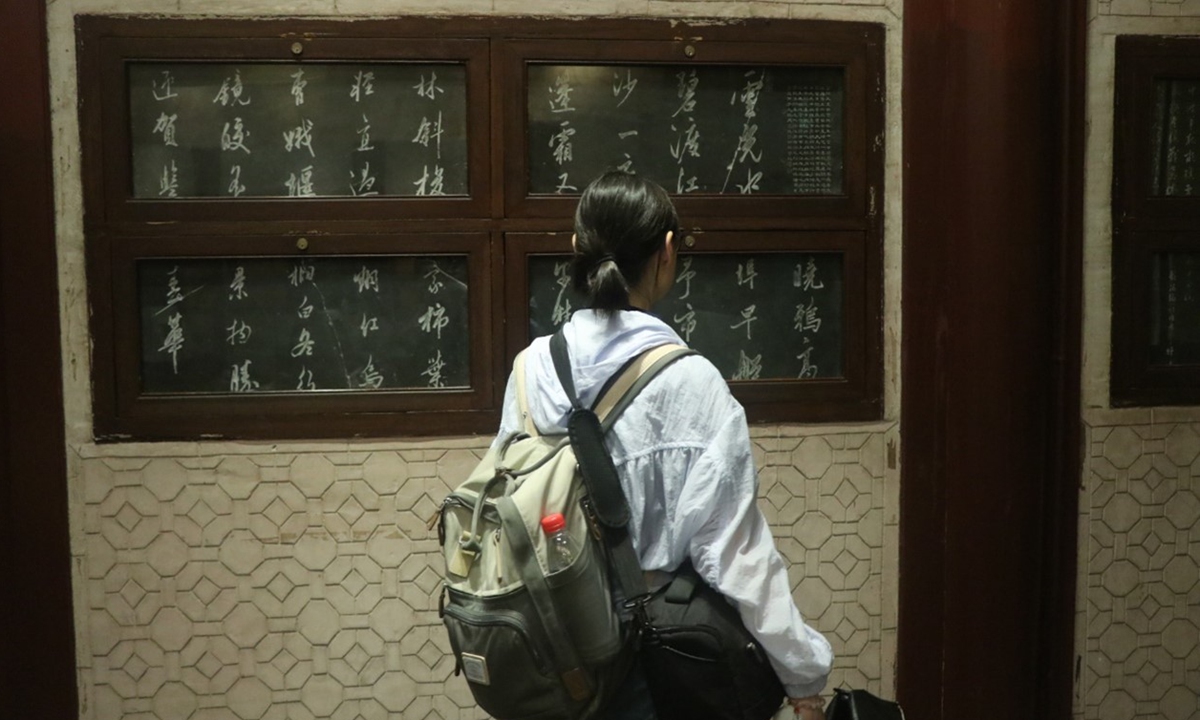Unveiling the secrets of China's oldest library: How it has thrived for over four centuries

Tourists are seen visiting Tianyige library during the rainy season in Ningbo, East China's Zhejiang Province. Photo: Zhu Xiaoyi
Hidden in downtown Ningbo, a historic city of learning and culture in East China's Zhejiang Province, there lies a library which has survived for more than 450 years, making it the oldest not only in China but in Asia, and one of the three oldest private libraries in the world.
The library, Tianyige, attracts a number of tourists with its unique architectural design, valuable collections of ancient books, and unique anti-moisture techniques, which are needed given the torrential downpours that regularly soak the city in the rainy season.
A tour guide shared with visitors the good news released earlier this month that the library has collected a number of rare ancient books, including a volume originally from the library that had been missing for more than 200 years.
Now may not be the best season to visit the library, but given the remarkable story of how it survived for over four centuries, it is still a rewarding exploration.
Oldest private library in Asia
Founded over 400 years ago by Fan Qin, a court official of the Ming Dynasty (1386-1644), Tianyige library houses nearly 300,000 ancient books. It ranks with Italy's Malatestiana Library and Biblioteca Medicea Laurenziana as one of the world's three oldest family-owned libraries.
Historically, flooding and water damage have posed significant challenges to libraries. Tianyige library is no exception. Situated in Ningbo, a city to the south of the Yangtze River, it endures hot and humid summers as well as cold and rainy winters. These conditions make wooden buildings and paper particularly susceptible to mold and insects.
In June, Zhejiang Province enters the rainy season, characterized by high moisture and temperatures, which poses a risk for the books in the library.
According to the Zhejiang Provincial Hydrological Management Center, as of June 27, the province had received 337.4 millimeters of rainfall in the month, nearly double the total for the same period last year.
To combat moisture and moth damage, Tianyige library has employed innovative measures. It was built with a two-tier structure, with books stored on the well-ventilated second floor to avoid dampness and flooding from the ground floor. The bases of the bookcases are elevated, and quartz stones are strategically placed within them to absorb moisture.
Anti-moth herbal sachets are carefully positioned inside the bookcases. Additionally, to address the challenges of the rainy season, descendants of the Fan family have employed the "book-basking" method, which involves moving books out of the storeroom and airing them before the peak summer heat to prevent mold.
Despite the challenges, Tianyige library has successfully preserved its nearly 300,000 ancient books by continually refining its moisture-proofing and insect-repelling measures, as well as its book restoration techniques.
As well as using air conditioning and ventilation systems, the library is equipped with an all-weather temperature and moisture control device that maintains optimal conditions.
"The temperature in our storerooms is kept between 18C and 20C, with moisture levels maintained between 45 percent and 50 percent. Under these conditions, our ancient books are virtually unaffected by the rainy season," Li Yaoyao, head of the Culture and Tourism Development Department of the Tianyige library, told the Global Times.
Furthermore, the library has implemented special damp-proof covers, magnetic cabinets, and camphor wood bookcases with natural moth-repelling properties, Li said.
Beyond its precautionary measures, Tianyige library possesses advanced techniques for restoring damaged ancient books, a legacy that spans over 400 years from the Ming and Qing dynasties to contemporary times.
The restoration techniques at Tianyige library involve 28 steps, including investigation into the reasons for the damage, page removal, page cleaning, and page repair.
In ancient times, damaged books were repaired with a special paste made from Sichuan pepper, lime, and common rue, which effectively repelled moths. After the founding of the People's Republic of China, Tianyige library established positions for book restorers. Today, the library has developed a well-established and comprehensive system for passing down these techniques, according to Li.
"We have a professional team of ancient book restorers led by a national intangible cultural heritage skills inheritor. When it comes to severely damaged books, they have to spend a whole day repairing only one page," Li said. "The restoration process begins with finding 'matching paper,' which refers to paper that matches the original text in material, color, and texture, from our sample library. The damaged paper is then flushed with water to flatten it. After that, the restorer cuts the matching paper to the appropriate shape and size, then uses the special paste to attach the "matching paper," filling in the missing parts of the ancient book."

A tourist reads inscriptions inside Tianyige library in Ningbo, East China's Zhejiang Province. Photo: Zhu Xiaoyi
Soft power of Ningbo's culture
"The Fan family had strict rules, stipulating that outsiders were not allowed to enter the library and none of the books could be taken out," the tour guide said.
Although Tianyige is no longer privately owned, the library still follows the tradition of its original owners to ensure the preservation of the books in the library's collection.
To allow visitors to grasp a deeper knowledge of this ancient heritage and get a closer insight into the 300,000 volumes, the library is digitizing the ancient books and also plans to build a southern pavilion, which will enable more people to appreciate the ancient books firsthand, Li said.
Ningbo's slogan is "City of Culture, Gateway to the World," and Tianyige library is a vital part of the local heritage. "Tianyige embodies the soft power of Ningbo's culture," Li said.
Amid the incessant rain, the Global Times met a tourist from South Korea, who excitedly discussed his visit, which allowed him to get an in-depth understanding of the history and culture of Ningbo and appreciate the wisdom of modern techniques in China.
The two-story wooden building is still standing after more than 450 years of wind and rain, and the core spirit is still the persistence of book lovers and family culture, which is deeply moving, another tourist said.
Yu Hexin, Zhu Xiaoyi, Xi Qingrui, Ji Longyu, Hu Ping, Yang Ruochen, Huang Rushi from the Communication University of China contributed to this story

